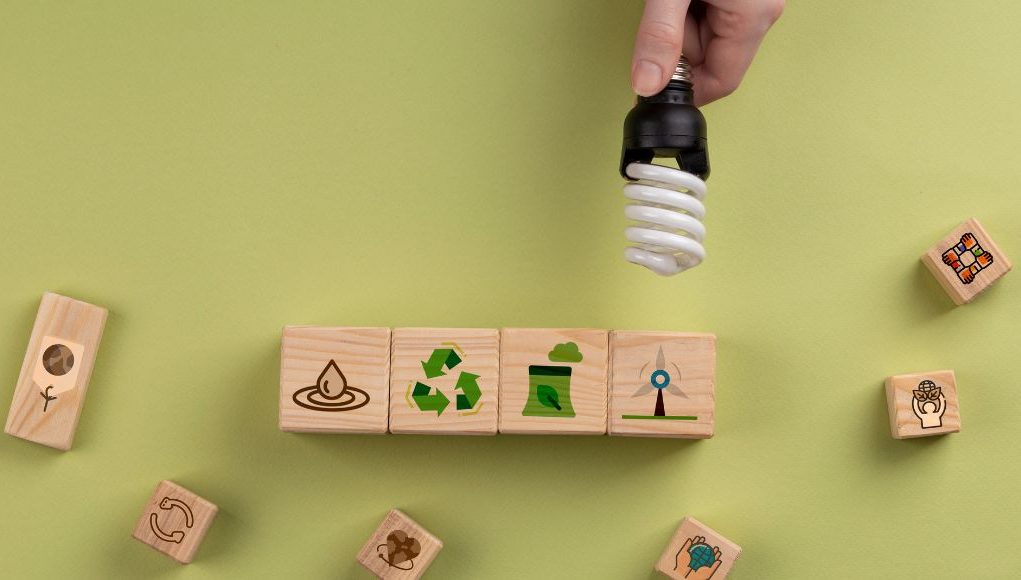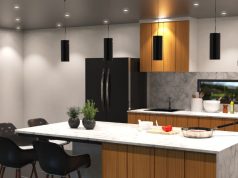Ever looked up at your lights and wondered, “Are my home lights impacting the environment?” Not yet? Then it’s about time you did, since the answer is YES.
You can’t see it, but even that cheery one dangling over your kitchen table is quietly having an environmental impact through its carbon footprint—the traces of carbon emission it leaves behind.
But the lighting carbon footprint is not the same across all light fixtures. In fact, not all bulbs are created equal, and when it comes to reducing carbon emissions, modern lighting is positively brilliant.
In this post, we’re flicking the switch between old and new lighting tech to see how each stacks up in terms of carbon footprint, and how LEDs aren’t just a bright idea, but also an environmental hero. Let’s dive in.
What is a Carbon Footprint?
First things first: what exactly is a carbon footprint?
Put simply, it’s the total amount of greenhouse gases (you know, those evil gases that trap heat in the Earth’s atmosphere we’re taught about in school), mainly carbon dioxide, released into the atmosphere as a result of a particular activity or product.
In the case of lighting, we’re looking at emissions from three main stages:
- Manufacturing (aka initial embodied energy—we’ll talk about this in a bit)
- Operation(how much electricity it gobbles up)
- Disposal (whether it ends up in a landfill or gets recycled).
Every time we flick on a light, we’re triggering some level of emissions, especially if your electricity is coming from fossil fuels. Yes, carbon footprint is not generated solely by your light per se, but rather by the whole system that makes it run, like a domino effect.
Add up the number of lights in your home, office, or city, and you start to see how lighting can either be a silent culprit or a silent champion in the fight against climate change.
Embodied Energy in Lighting Manufacturing
Let’s start at the beginning. Yes. Before the bulb even reaches your ceiling, it has already contributed to greenhouse gas emissions.
Embodied energy refers to all the energy used in the production, transportation, and installation of a product. For lighting, that means mining raw materials (like tungsten, glass, or phosphor), processing them, assembling the components, packaging them up, and shipping them off to your local shop or online basket.
Older lighting types, such as incandescent bulbs and compact fluorescents (CFLs), are surprisingly low on embodied energy. That’s because they’re fairly simple creatures. A filament, a bit of gas, a glass envelope, and voila! Light! But don’t be fooled. That doesn’t mean they’re greener overall.
LEDs, on the other hand, are more complex to make. They require more advanced materials and manufacturing processes, so their upfront carbon cost is higher. Sounds bad, right? But this is where the irony kicks in. Because once they’re up and running, LEDs pay that energy debt back faster than you can say “carbon emission.”
In summary:
- Older lights = low upfront carbon cost, but high operating carbon cost
- LED lights = high upfront carbon cost, but low operating carbon cost
Comparing Operational Energy Use
We’ll finally see which light stomps and which one tiptoes based on the footprints they leave behind.
Let’s paint a scenario:
Say all the lights run on the same 800 lumens brightness for three hours per day…
- An incandescent light at 60W and a lifespan of 1,000 hours will consume an annual energy of about 65.7 kWh.
- A CFL at 13W and a lifespan of 8,000 hours will consume an annual energy of about 14.24 kWh.
- An LED at 9W with a lifespan of at least 25,000 hours will consume an annual energy of about 9.86 kWh.
Alright, it’s cool to know and all, but what does that have to do with low carbon lighting?
Keep your seatbelts on because here’s where it gets interesting. In the UK, the average emission rate per kilowatt-hour in the past 5 years (2020 to 2025) is around 0.23 kg of CO₂. With just a little more math we can get to the conclusion:
- Incandescent: 65.7 kWh x 0.23 = 15.11 kg CO₂/year
- CFL: 14 kWh x 0.23 = 3.28 kg CO₂/year
- LED: 10 kWh x 0.23 = 2.27 kg CO₂/year
Over the lifetime of one LED (25,000 hours), you’d go through 25 incandescent bulbs. The CO₂ difference from manufacturing to disposal? Massive.
It’s like LEDs are allergic to high energy costs while incandescent bulbs are lounging on the sofa, snacking on fossil fuels.

LEDs and Lifetime Carbon Reduction
You still following? Good. Now let’s talk lifetime impact.
We’re telling you now, LED’s environmental savings are impressive:
- One LED bulb, on average, can reduce over 250kg of CO₂ emissions during its life compared to an incandescent bulb.
- Multiply that by every bulb in the average UK home (the average is surprisingly 40), and you could be cutting lighting emissions by 10 tonnes of CO₂ (at least!).
That’s the same as driving in a loop from London to Edinburgh 32 times. And that’s just a rough estimate!
Unsurprisingly, LEDs are getting even greener. Newer models are more efficient, use less rare-earth material, and are increasingly recyclable. Some even come with smart features to reduce power consumption even further.
Read more on Lighting and Sustainability: A Greener Future.
Making the Switch for the Planet
We get it. Incandescent lights look warmer, and they give that nostalgic vibe modern lighting just can’t seem to fully replicate. Or maybe you’re just clinging to them out of old habit—we’re not here to judge. But making the switch to eco friendly lighting options (meaning LED) is one of the easiest, most affordable eco-upgrades you can make.
We’ll help you do it smartly:
1. Do a Home Lighting Audit
Go room to room and check what types of bulbs you have. If they’re halogens, incandescents, or older CFLs, it’s time to retire them. Plan out replacement and recycling.
2. Prioritise High-Use Areas
Let’s be real. You don’t use all your lights every day at the same time. Start replacing the lights you use most: the living room, kitchen, and bathroom. The rest you can change later. Remember: The more hours a bulb runs, the faster the carbon and cost savings add up.
3. Choose the Right Colour Temperature
Warm white LED lights (2700K–3000K) mimic the cosy glow of incandescent bulbs without the carbon guilt.
4. Use Dimmers and Sensors
Lowering brightness and turning off lights when not in use are some good practices that reduce electricity use (meaning less carbon footprint). Lights outdoors, in hallways, and in toilets are often left on unnecessarily. Pair those with dimmers, timers, or motion sensors.
5. Recycle Responsibly
Be the good Samaritan (towards Mother Nature) and don’t just bin your lights. There are recycling facilities on the way to the shopping where you can drop them off.
Final Thoughts
Lighting may seem a little insignificant when you think about energy consumption, but it packs a serious carbon punch if left unchecked. Don’t wait before you’re hit with a strong right upper cut before you take action.
The good news? Switching to modern lighting—especially LEDs—is a low-effort, high-impact way to shrink your carbon footprint.
It’s the kind of good deed that pays you back in spades:
- Financially: Lower bills and fewer replacements.
- Environmentally: Massive reduction in greenhouse gas emissions.
- Emotionally: That warm glow isn’t just the bulb. It’s your eco-conscience glowing with pride.
So make the switch. The Earth will thank you—and so will your energy meter (and your wallet, of course).













